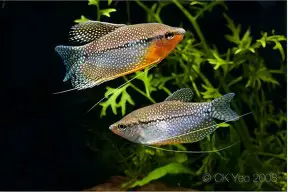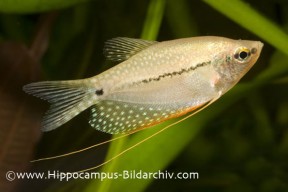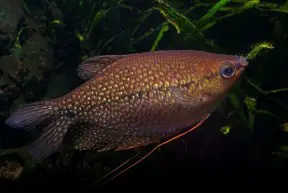Trichopodus leerii
Pearl Gourami
Classification
Osphronemidae. Subfamily: Luciocephalinae
Distribution
Found in Thailand, Malaysia and the islands of Borneo and Sumatra. There are now also introduced populations living in both Singapore and Colombia. Wild fish are rare in the hobby these days, with the vast majority of the ones on sale being mass-produced in the Far East and Eastern Europe.
Habitat
Inhabits lowland swamps, often in coastal regions.
Maximum Standard Length
4.8″ (12cm)
Aquarium SizeTop ↑
36″ x 12″ x 12″ (90x30x30cm)
Maintenance
A planted setup with some floating vegetation and open areas for swimming.
Water Conditions
Temperature: 75-86°F (24-30°C)
pH: 5.5-8.0
Hardness: 2-30 dH
Diet
Unfussy and will accept most foods offered.
Behaviour and CompatibilityTop ↑
One of the most peaceful gouramis and an excellent community fish. Males are territorial with one another however and can also be quite hard on the females when they want to breed, so ensure there are adequate hiding places in the aquarium. Do not keep the pearl gourami with aggressive or very vigorous fish or it will become withdrawn.
Sexual Dimorphism
Mature males are much more colourful than females, developing a stunning orange or red colouration around the throat area. They also have extensions to the dorsal and anal fins. Females are blander and plumper.
Reproduction
Easy. Bubblenester. The breeding tank should contain water of no more than 6-8″ in depth with lots of floating plants. Filtration should be gentle and air-powered filters are ideal. Condition the fish with live food. When the female becomes plump with eggs the male will construct a large bubblenest of up to 10″ diameter amongst the floating plants. He will then begin to display to the female. As the female approaches the nest the fish can be seen touching each other with their modified ventral fins. Spawning occurs under the nest in the typical anabantoid embrace. The eggs float upwards and the male shepherds them into the nest. Several more spawnings occur and between 200-300 eggs may be produced. When there are no more eggs the female is chased away. It is best to remove her at this point or she may be seriously harmed. The male then tends to the nest until the eggs hatch, usually in around 20-30 hours. The fry become free swimming in another 4-5 days, at which point the male should also be removed. They should be fed infusoria or liquid fry food for the first week, after which they are large enough to accept brine shrimp nauplii, microworm and powdered flake. The fry grow very slowly and care must be exercised when doing water changes as they are very susceptible to changes in water temperature for the first 3 months or so.
NotesTop ↑
A very hardy, beautiful species which is highly recommended to the beginner. A male in full breeding dress is one of the most stunning fish available in the hobby. T. leerii is alo fairly long-lived and may survive for 8 years or more in the aquarium. These fish will also consume the aquarium pest hydra.





October 31st, 2012 at 4:20 am
I had three of these with some 3 spot gourami, there was no fighting or aggression in the tank, the tank is 30 x 12 x 24 inches, suddenly 2 of the pearls stopped eating and died then after 15 days the third went the same way please help
October 31st, 2012 at 9:45 am
Hi, please use our forum or ‘Questions and Answers’ sections for this kind of query, you’re more likely to get a useful response there.
The comments sections on species profiles are intended for those wishing to add to the information in the profile itself. 🙂
May 26th, 2014 at 12:57 am
I have kept a pair of these fish in 20 gallon for over a year, they now live in 50 gallon. I have noticed now aggression of the male towards the female,the two fish also behave like bonded pair.
May 26th, 2014 at 1:50 pm
With gouramies, bettas etc. the agression is used in order to make the female produce stress hormones. It’s becouse they use it to enchance breeding and to make better eggs. That’s the opposite to what normally happens with fish from other taxons.
May 26th, 2014 at 2:06 pm
Are any references regarding the latter phenomenon available?
October 1st, 2014 at 5:56 pm
Hardness: 2-30 dH
Seems a very wide range considering other gourami species are soft/medium water lovers. Has anyone kept then at >18dh for extended periods without issue?